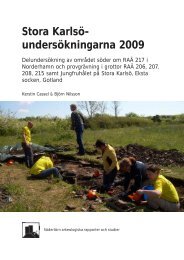CIVIL SOCIETY IN PEACEBUILDING - A Case Study Analysis of ...
CIVIL SOCIETY IN PEACEBUILDING - A Case Study Analysis of ...
CIVIL SOCIETY IN PEACEBUILDING - A Case Study Analysis of ...
You also want an ePaper? Increase the reach of your titles
YUMPU automatically turns print PDFs into web optimized ePapers that Google loves.
conflict. They are established to prepare and facilitate negotiations and reconciliation efforts betweenfighting actors (Lederach 1997:50).The grassroots-level represents the population, citizens who form the base <strong>of</strong> a society. Grassrootsalso include people involved in local communities. It is an important level because <strong>of</strong> its heavy weightedmass. Because local communities <strong>of</strong>ten are split into several groups, sometimes hostile, grassrootsinitiatives <strong>of</strong>ten deal with deep-rooted hatred and animosity between fighting actors. Factors such associal and economic insecurity, political discrimination and human rights violations are primarilyexperienced at the grassroots levels. The grassroots level face challenges from those confronted by theelite and the middle-range. The bottom-up approach to peace features several approaches targeted to thegeneral population. In fact, many transitions towards peace are driven largely by pressure from thegrassroots level (Lederach 1997:52) and therefore actions taken at this level is crucial to reducingconflicts destructiveness.8.2 Bottom-up - peacebuildingPeacebuilding through a ”bottom-up” approach is about integrating the various levels and spheres<strong>of</strong> society where the goal is a unified social cooperation, which requires strong links between society’stop-, middle- and grassroots levels. Effective peacebuilding can thus not only be about a 'neutral'intervention and peace agreement at the elite level, but must also include the strengthening <strong>of</strong> localcommunities. The importance <strong>of</strong> this is in particular about changing attitudes and values among citizens,which can be difficult to achieve through diplomatic negotiations at the elite level between the parties,but perhaps easier through mediation at the grassroots level <strong>of</strong> conflict (Ramsbotham et al. 2005: 215-218). The approach also involves peacebuilding from below to link conflict resolution from a broaderperspective than the state, where international or global influences are linked to the local community.Interestingly, this perspective can identify and support peaceful local cultural resources, traditions,customs, workshops and institutions and work towards positive peace structures also in conflict to createa framework which you can work even after a conflict ends (Ramsbotham et al. 2005:218-221, 229).Certainly, this task may be easier in a relatively peaceful society than in a conflict society where suchdehumanizing propaganda and violence structures are part <strong>of</strong> everyday life, but it is not necessarilyimpossible.Peacebuilding in civil society unfortunately includes parts <strong>of</strong> civil society that stands forunpeaceful values and activities where there is a risk that the conflict spreads to hierarchical andmilitaristic structures <strong>of</strong> civil society (Ramsbotham et al. 2005: 229).21
















